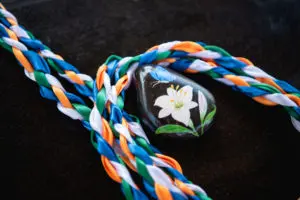Handfasting – 5 facts you may not know about Handfasting ceremonies at Dode.
7th June 2024
1. Handfasting ceremonies predate Christian wedding ceremonies.
Handfasting ceremonies were first documented almost 9,000 years ago, in Ireland. The Celtic tribes would symbolically join a couple using cord, ribbons or plaited cloth. The couple would declare their intention to marry in front of their families and the tribal elders. Some tribes would regard this as the full wedding, others had an engagement period of a year and a day. After this period a second handfasting would take place, uniting them until death.

Photographer: Emily Brown Photography
2. Tying couples together symbolically is part of many different religions – here are four examples
There are versions of hand tying rituals in Catholic and Christian weddings, when the priest or vicar covers the couples hands with his/her stole during the blessing.
In the Hindu faith, there are several ritual knot tying ceremonies, but in particular the Hasta Milap involves the bride’s parents tying the couple’s right hands together with a cloth to present their unbreakable bond.
In Sikh Ceremonies the bride and groom both have red cords tied around their wrists, and later during the ceremony, the Father Of The Bride places a Saffron coloured scarf on the room’s Shoulder and the other end in the Bride’s hand to symbolise that they are now joined and ready to take their vows.
In Mexico there is a Lozo ceremony, during which a large look of rosary beads or a ribbon is placed in a figure of eight around the couple’s shoulders to symbolise their eternal bond and unity.
3. Handfasting and hand tying are different versions of the same thing.
Handfasting traditionally involves a mores spiritual element, whereas hand tying is a modern symbolic ritual. In a Handfasting ceremony at Dode your celebrant may create a sacred circle within the stones, and using a compass will place 4 elements. Fire in the South, representing passion and love. Earth in the North, so that your love is grounded and natural. A feather or fan in the east, to represent the air which flows through you. Water in the West, to symbolise the purity of your love.
In a hand tying ceremony, the vows and promises are more grounded in you as a couple, and the hand tying may follow the rule of three – three wraps around your wrists, one for the past you share, one for the joy you feel now and one for the love in your shared futures. You can choose which you prefer, or discuss with your celebrant ideas to incorporate your own spiritual beliefs and values.
4. Handfasting is the origin of several well-known phrases.
Literally, when you have a handfasting, you are “tying the knot” and creating a “love knot”. Many also refer to the “bonds of matrimony”, those invisible threads which connect you with your beloved, and which at times can weigh heavy as life intrudes. Handfasting reminds us that even in the bad times, we are bound together and so can face each challenge with our life partner, because you are “tied together”.
There are many different ways to “tie the knot” in a hand fasting.
The photos above show different ways couples have tied the knot. Couples may prefer to stand side by side and place their right hand on top of their partner’s left hand. Other couples want to face each other, and have their wedding rings connected during the handfasting, creating an eternity symbol within the knots. Some couples prefer to have their hands on each other’s shoulders and have the knot tied and the ends of the rope put into each other’s hands, so that when they pull apart, the knot remains in the middle.
The knot can be tied in the middle of the cord, leaving the ends free for you to hold, with the knot between you. Others prefer the knot to be tied with the ends of the cord, meaning that it makes a circle or heart shape. There isn’t a right way, just your way!
5. You can use anything to make the cord with – there are no rules!
The cord is symbolic of you as a couple, and as such it reflects your tastes and skills. Some couples prefer to purchase an intricately woven cord in colours they like. Others prefer to plait their own cords together prior to their wedding day. For some couples, the colours are very important, and your celebrant will share the meanings with your guests as the cord is tied. You can use a variety of materials to create your cord. Ribbons, cords and wool, woven strips or crochet – whatever you prefer. Some couples like to add tokens to the cord to represent different aspects of their romance or faith. Others prefer to use materials associated with their work or events in their lives – for example twine for gardeners, fishing line, or off cuts of cloth used by a seamstress. Others incorporate items of clothing which are important to them – a strip of cloth from a parent’s wedding dress, or a tie or strip from a shirt. In some handfasting rituals, the cloth is cut in strips and laid onto the joined hands one strip at a time, the knot being tied at the end to keep the strands together.
However you choose to celebrate your handfasting ceremony at The Lost Village of Dode, Becky and the team will ensure that you have the most magical day ever!
Celebrant Kate helping you to find the words.
0759 3311074 www.celebrantkate.co.uk
